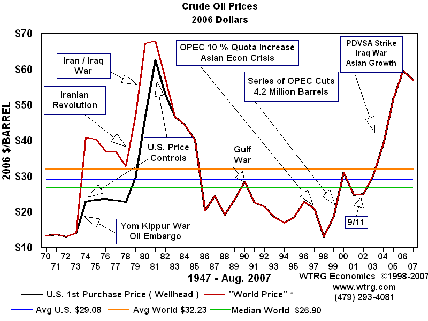The Telegram front page today carries a story on the provincial government's revenue estimates for the Hebron project in three scenarios. The scenarios use oil at an assumed average price over the life of the project at US$50, US$87 and US$113 (constant 2008 dollars). The story is also available online.
 Given that oil prices haven't averaged anything near US$87 or US$113 over the past 25 or 30 years, that US$50 a barrel estimate in constant dollars is probably a little closer to the likely performance of oil prices sometime after 2018. In that scenario, the provincial government estimates revenues at $6.8 billion, including $5.4 billion from the revised royalty regime.
Given that oil prices haven't averaged anything near US$87 or US$113 over the past 25 or 30 years, that US$50 a barrel estimate in constant dollars is probably a little closer to the likely performance of oil prices sometime after 2018. In that scenario, the provincial government estimates revenues at $6.8 billion, including $5.4 billion from the revised royalty regime.
That royalty regime keeps royalties at a constant 1% up to simple payout and then provides for an additional 6.5% in any month after simple payout in which prices average above US$50 for West Texas Intermediate at Cushing, Oklahoma.
To see the impact of oil prices on the revenue projections using the revamped royalty regime, all you have to do is lop one measly dollar off the assumed average price. At US$49 - a 2% drop from the government's assumed average price - the province's royalty take drops by at least $1.25 billion. That's 23% less. Factor in the loss from the changed royalty regime, which government estimates at $105 million at the average price of US$50 a barrel and the loss climbs.
The provincial estimates see the 4.9% equity position generating $800 million for the energy corporations oil subsidiary at the US$50 price assumption. This appears to be based on total costs for the company of $600 million over the life of the project (construction to decommissioning).
Based on the provincial government's own estimates of costs for acquisition and the construction phase, that would assume the OilCo's share of all production and decommissioning phase costs at $200 million. That works out to a total projected cost of $4.0 billion for ongoing operations of the rig, exploration, delineation and production drilling after first oil and whatever share of decommissioning costs the oil company will bear. It would also have to include any fees and charges for handling the sale of crude which represents the OilCo share of production.
Low-balled costs? Could be. Bond Papers' preliminary estimate of lifecycle costs for OilCo came in at about twice the amount apparently used in the provincial government calculations. Bond Papers used a figure of $10 billion as the cost of operations expenditures and production phase drilling, and decommissioning costs, including the $250 million for a liability guarantee.
Fixing an accurate estimate of the costs after first oil would help refine the calculations. That may be difficult, though, since the acquisition agreement between the provincial government and the oil companies hasn't been released to the public. It might become somewhat easier when and if a development application is filed with the offshore regulatory board. That application would include a forecast of drilling activity for the production phase.
-srbp-
Related:
- "Hebron second royalty: a second view". (August 2007) Examines the Hebron royalty, as originally presented in the memorandum of understanding, using an assumed average price in constant 2005 dollars.
- "Hebron basic royalty: a preliminary assessment" (August 2007)
- "Masters of our domain: Williams concedes on royalties". (August 2007)
- "History repeating itself".(August 2007). Notes the impact of changing assumptions on the price of oil on perceptions of the "value" of a deal.